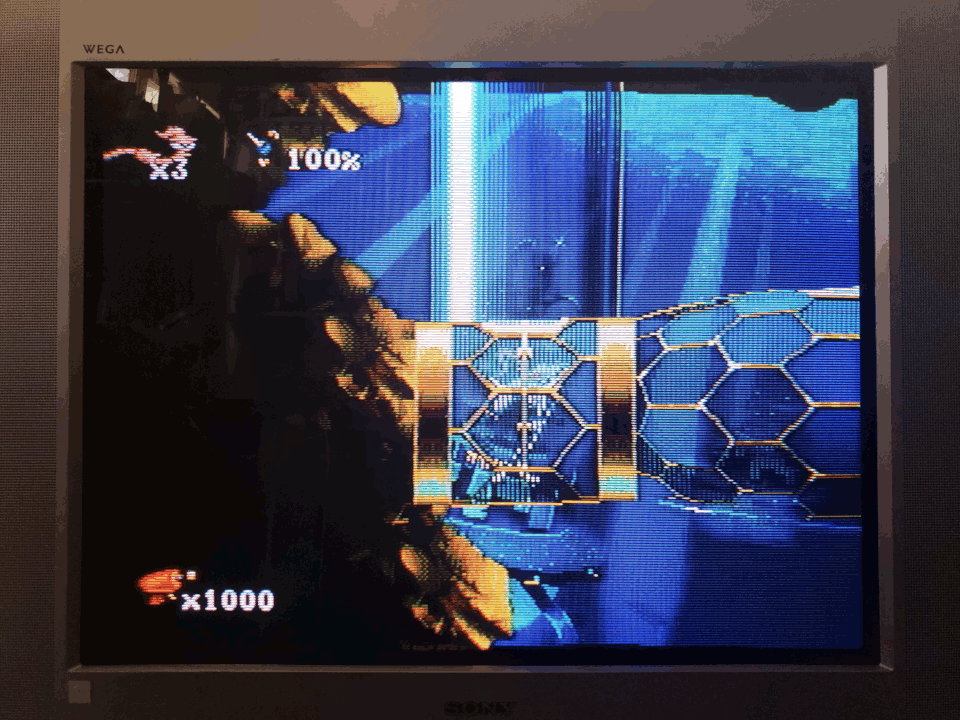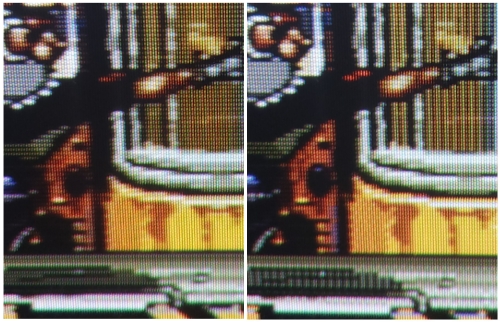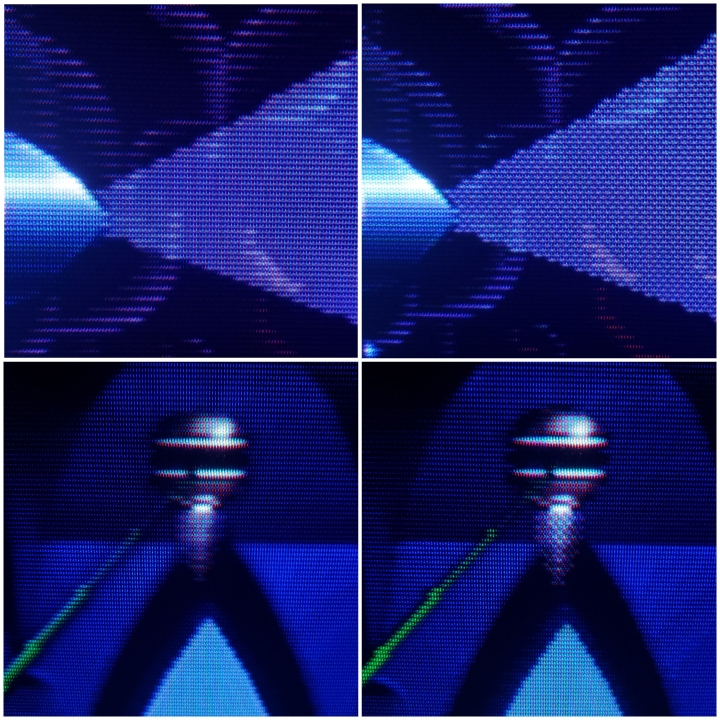
This is a compilation of interview excerpts with twelve different designers on their development process for the Genesis/Mega Drive - specifically how consumer CRTs and video standards of the time fit into that process. For some context, the system came with an RF adapter in most countries including in Europe[1].

Note that RF and composite have the ability to blend dithering patterns, unlike RGB, component, and S-Video. Interestingly, some common comb filters used in TVs actually prevent proper blending in RF/Composite, so be sure to check that it's working in your setup.
When using RF/Composite, artifacts can appear to varying degrees, such as dot crawl/hanging dots (cross luminance/chroma mesh failure) and "rainbowing" (cross color). These artifacts can be mitigated based on hardware component selection, which will be covered in a separate article.

Source 1- Devs Play S01E01; Louis Castle - The Lion King, Dungeons & Dragons: Warriors of the Eternal Sun, etc.
"You can actually see every single pixel which means it looks nothing like it did back in the 90s. Those hash patterns actually on the televisions of the day would've blurred together into very nice gradients. I think that's why people have a misimpression of how this stuff looked."
"Again, it doesn't do it justice when you see it all pixelated, because on a television of the day this was all very smooth and the palettes really matched the beautiful work."
https://www.youtube.com/watch?v=kILeyo1iv0A

Source 2 - Playing at the Next Level: A History of American Sega Games, p.183; Eric Iwasaki - X-Men, Spider-Man, Menacer 6-Game Cartridge, etc.
"[Eric] Iwasaki and the other artists used a Sega-developed program called Megawice for laying out art within 8x8 character tile maps. This was a common method on hardware of the period, as it efficiently rendered sprites and scrolling backgrounds. The artists would create their sprites in Deluxe Paint: Animation and then import them into Megawice. Then, they previewed the graphics on an actual television connected to Genesis hardware."
https://books.google.com/books/about/Playing_at_the_Next_Level.html?id=hxhmDQAAQBAJ
Source 3 - The Minds Behind Sega Genesis Games: Interviews with Creators and Developers, p.108-109; Steve Ross - X-Men, X-Men 2: Clone Wars, Chakan, Pink Goes to Hollywood, Taz in Escape from Mars, etc.
"Steve Ross, the guy who was the lead on Chakan, was also the lead artist on X-Men. When I first met him, his ability to play with those limited pixels and palettes was really great. He had this amazing sense of 3D and shading and things. I'd never met someone who had that kind of skill with pixels. That was his thing. He did a lot of blending of different colors. You know, you were drawing things on a CRT, and you could be defeated by all the smearing of pixels...color changes ended up smearing across multiple pixels. You could find yourself defeated by that. It wasn't like drawing like an LCD display today. He took advantage of it though, and used all that blending to come up with in-between colors that weren't directly available on the palettes. A lot of the way to get any extra depth in the colors was doing these alternations from one pixel to the next between adjacent colors. When we looked at it on the Mac display, we'd look at the artwork coming in from the paint program, and it looked chunky. But then when you drew on the TV, it's like, 'Wow.' You'd see the end result. He was just a master at tuning that."
https://books.google.com/books/about/The_Minds_Behind_Sega_Genesis_Games.html?id=wSV6EAAAQBAJ
Source 4 - The Minds Behind Sega Genesis Games: Interviews with Creators and Developers, p.21; Ellis Goodson - Jurassic Park, Technoclash, Shadowrun, Jurassic Park: Rampage Edition, Vectorman, Vectorman 2, etc.
"You would go to Ellis and you'd say, 'This background looks kind of plain. Let's put a section where there's a wooden fence.' Thinking he'd get back to you pretty quick. After a while you'd start thinking, 'Hey, where's Ellis?' You'd go over there and see an incredible fence on his monitor, but he would be really focused on one of the planks in the fence and how to render it properly, so that it looked really good on a television screen."
https://books.google.com/books/about/The_Minds_Behind_Sega_Genesis_Games.html?id=wSV6EAAAQBAJ
Source 5 - Sega-16 Interview[2]: Robert Hunter (Game Artist); Adventures of Batman & Robin (Genesis), Batman Returns (Genesis), etc.
Sega-16: Many artists had to find ways to work around the limited color palette of the Genesis. Was this ever a problem for you?
Robert Hunter: It was tough, but thanks to how fuzzy NTSC displays were, you could create very cool dithering patterns that looked seamless to give you more colors than really existed.

Source 6 - The Game of Nerds - Vectorman 25th Anniversary[3]; Jeff Jonas, artist for Vectorman, Jurassic Park (Genesis), Shadowrun (Genesis), etc.:
"We had learned from Shiny Entertainment and other competitors how vertical line blending was more preferable on the TV than straight dithering. That is why everything looked weird on the PC. Those vertical lines blend automatically on the TV."

Source 7 - How Did This Get Played? Ep. 19[4] Eternal Champions: Developer’s Commentary (w/ William Kier); artist for Eternal Champions & Eternal Champions 2
Heather Anne Campbell: Do you have to do each dot in dithering?
William Kier: Yes
Heather Anne Campbell: You do?
William Kier: Yeah, you're just painting a checkerboard essentially.
Heather Anne Campbell: Oh my god.
William Kier: And it was - so on the computer it's very dithered but on the TVs we did it so that the colors would blend together better. But now when you look at it on the monitors, it's, you can see just all the-
Heather Anne Campbell: I thought that would be like a brush, where it would be like 'oh this section is dithered', but you did it manually.
William Kier: Oh man it was all mouse artwork, it took a long time.

Source 8 - Shmuplations Translation of Ayano Koshiro Interview[5]; artist for Streets of Rage 2, Beyond Oasis, etc.
Wada Makoto Mamoru: When you were developing for the Megadrive, what was the one hardware feature you wished for most?
Ayano Koshiro: Transparencies!
Wada Makoto Mamoru: Hah, I knew it.
Ayano Koshiro: Transparencies. The Super Famicom had those. Luckily the Megadrive could achieve a dithering effect by having the colors of long, thin pixel lines blend into each other. That’s why when we first saw that transparent waterfall in Sonic we were all really impressed. How did he do it? Then when I looked closely it was like, “oh, I see.” (laughs) That waterfall effect in Sonic was so pretty.

Source 9 - Ancient Blog Post on Bare Knuckle II Development[6]
"Today, we would use semi-transparency to represent spotlights, but the Mega Drive didn't have that function. So we created a pseudo-transparency by placing transparent and opaque pixels in a checkerboard pattern. This expression looked beautiful because of the TVs of the time, which were prone to bleeding, but on today's monitors, where the pixels are clearly visible, it looks dirty...on an actual TV it looks even more clear and beautiful."

Source 10 - The Retrohour Podcast - William Anderson Game Designer[7], Aladdin, Jungle Book, Cool Spot, etc.
"The way the Genesis works is if you space white lines one pixel apart form each other you can get a glass effect. But what we discovered at Virgin is if you put two different colors together, with that same effect you could get color bleed which would give you more colors on the Sega Genesis than technically you were supposed to have. If you actually look at the sprite sheets for Jungle Book, Cool Spot, Aladdin, you'll see there's actually these bands of lines in the artwork that look kind of weird. But if you take into consideration the bleeding effect, it explains why we're getting more colors than we should be getting, and it really did help with that authentic animation look. It made them look like they could be cartoons on TV."

Sources 11 & 12 - Phantasy Star: 31 Nenme no Genten[8]; Yasushi Yamaguchi, artist for Super Thunderblade, Sorcerian, Kid Chameleon, Sonic CD, Sonic 2; Naoto Ohshima, artist for Phantasy Star II, Sonic the Hedgehog, Last Battle, etc.
Naoto Ohshima: Back then, the TVs were CRTs. With the Mega Drive's limited number of colors, we made use of the CRT's blurriness.
Yasushi Yamaguchi: At the beginning we were making everything on RGB monitors, and we expected it to appear on the TV like that. But when we actually saw the output from a Mega Drive on a TV it was totally blurry.
Naoto Ohshima: We'd use that blurriness to create intermediate colors.
Yasushi Yamaguchi: Yeah. We started designing everything to make use of the blurriness, but the surprising problem now is that recent re-releases on the PS3 or PS4 display the pixels as-is. I want to say, "Stop that!"


 This work is licensed under a
This work is licensed under a